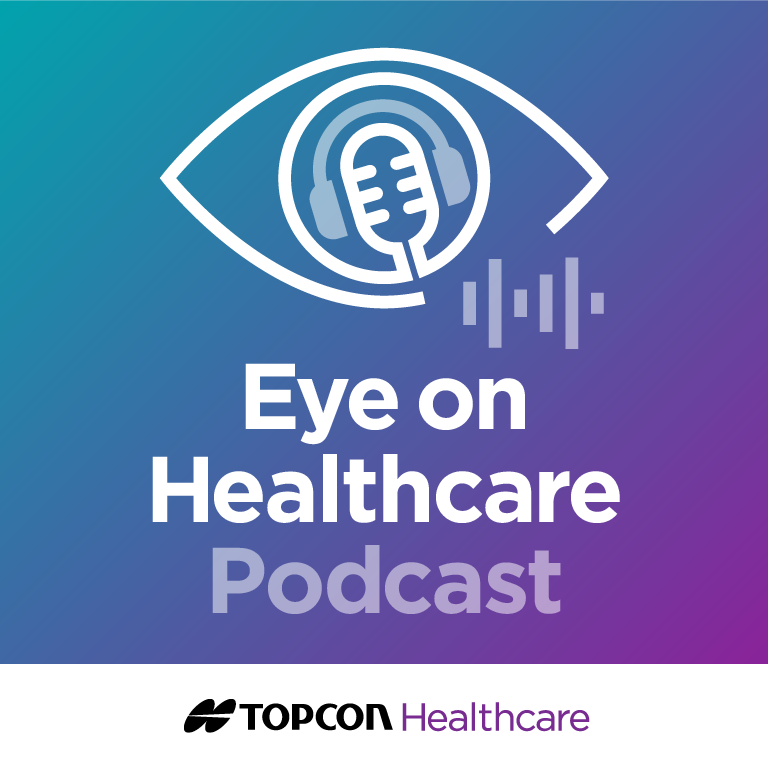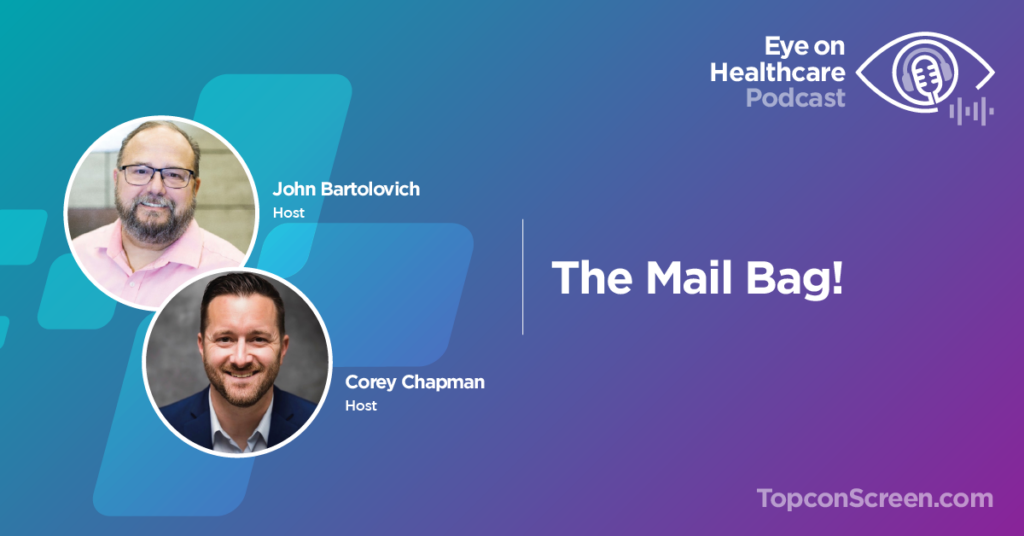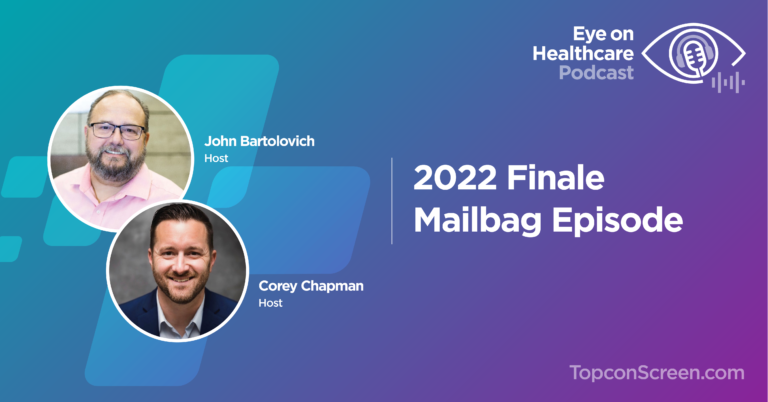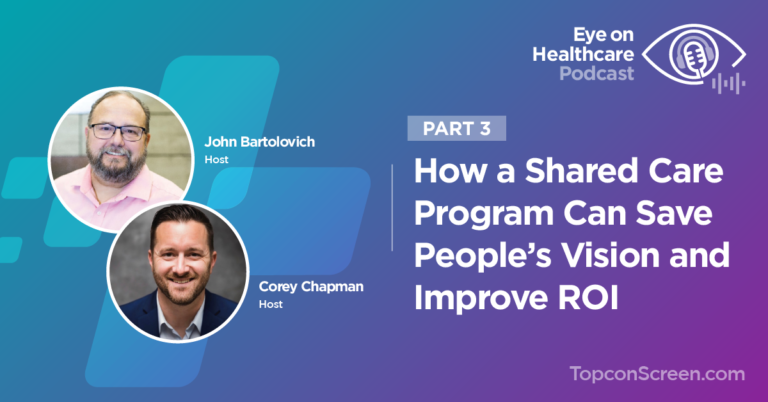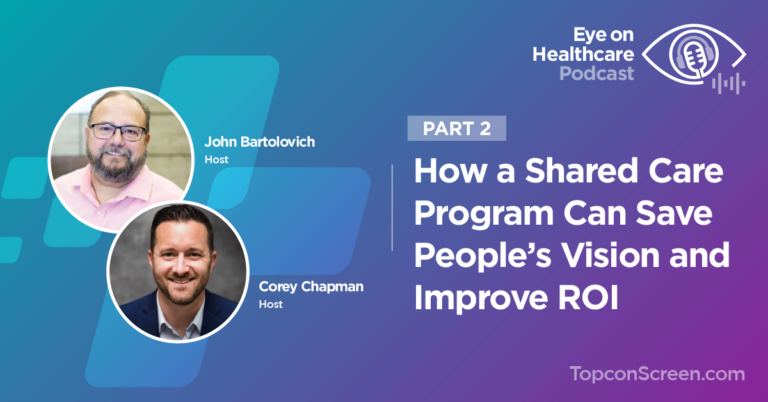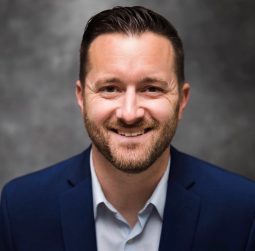Episode Transcript
John: welcome back everybody to another episode of the Eye on Healthcare podcast. I’m your host, John Bartolovich. I think I could really get used to this. Joined as always by my co-host Corey Chapman. Welcome, Corey.
Corey: Listen, John, I can get used to this too, OK, so be careful what you wish for. But yes, happy to be here, John. Happy to be here.
John: So, Corey, last time we talked about diabetic retinopathy, eye exams and what the current processes with the primary care physicians and what some of the trouble spots were and some of the hang ups. And this week what I wanted to do with your permission of course is to discuss how Topcon Screen helps to eliminate a lot of those burdens. So, if you don’t mind once you give us a quick recap on what some of the barriers to care, what Primary care physicians see when it comes to this initial diabetic eye exam.
Corey: Sure, sure. I love that curveball that started off you, like, you know what, we’re going to do a pop quiz. Were you paying attention last time? I like that, John. You know, we really take a consultative approach with each and every office health system. You know everybody that we work with, we want to know exactly what their pain points are and how we can help clear those up. What we hear over and over again is really if you can’t do the exam, any kind of testing at point of care there is that drop off. Once the patient leaves the office, you don’t know if they’re going to make it to that specialist office and what we typically see is a lot of social determinants of health, right? You know that patient maybe has taken half a day off of work to come to see their primary care physician, and now they’re saddled with the burden of an additional visits somewhere else, and those folks may have transportation issues. They may have socioeconomic issues where it’s why, I don’t know if I can afford to do another copay in the next few weeks. I’ve budgeted for this one. There are multiple reasons. Once a patient leaves that it’s uncertain if those type of tests are getting done. So, when we do talk about providing the best care for patients, we always lead with point of care testing because what we found out for the most part is that patients are loyal to their primary care physician. It changes the game when you’re asking them to go elsewhere. Unless of course it’s, you know, walking them right down the hall, you know, hand holding them right down the hall into the next spot. So, John, we’ve seen issues where the primary care office is on the 5th floor and ophthalmology is on the third floor. And all you got to do is put him in the elevator and hit two and hopefully they get off and they don’t, right? so many, many reasons behind that.
John: Well, I could honestly say, Corey, I personally witnessed a patient that literally just had to walk across the hall. And instead went down the hall to the elevators and left. So that is a burden. And who knows why that patient did that. It could be they just didn’t have the time because they had to get back to work or had to get back to take care of somebody.
Corey: So, I’ve told the story recently and you know. I went to see my optometrist. Now I’m not living with diabetes, but I, you know, go every couple of years, glasses, and contacts. And I went this summer. I went in July and they said something’s come up on one of your exams. We want you to see an Ophthalmologist. This is hand to God. True story. And I said OK the Ophthalmology office is connected to the optometry. Now there are two separate businesses, but they’re in the same building, right? And the only offices in this building, they handed me the card. They said obviously you can’t go there right now, but call make an appointment. Now I care about my sight. I care about all that. Do you know when I ended up seeing an ophthalmologist in that building? True story: December 31st. Now, that wasn’t because they couldn’t see me. That wasn’t because of scheduling issues or cancellations. That was me going. Yeah, I’ll put it on. I’ll take care of that tomorrow or I’ll take care of that next week. And it took me five months to get that done. So. Someone who’s you know, just going in for the next exam and I’m preaching it all the time and I couldn’t get it done. It was almost like when I was in the Optometry office. Can’t you do that here? Right. So that’s that mentality that we talked about. Can’t we just get everything done right here one stop shop?
John: I’m sure a lot of it also had to do with you not experiencing any symptoms, correct?
Corey: That’s the other thing. Yes.
John: And that’s something that we hear a lot from the diabetic patient is my eyes are fine, right. So, one of the things we also talked about on a podcast is delaying this exam. It could potentially lead to some very serious consequences and cause in excess of $20,000 annually if we don’t catch this early enough. So why don’t you explain to our audience, Corey, how Topcon Screen helps to catch this very quickly at point of care?
Corey: Right. And again, my mantra is and it always will be and probably throughout this show is point of care, point of care, point of care, right? So, we talk about having the ability to go into a PCP’s office and it being a one stop shop for every possible need. You’re seeing a lot more of these PCP offices bringing in labs, whether it’s right inside the office or right next door or down the hall because they understand that again because we talked at the top of this show, having a patient leave the office, there’s a question mark if they’re going to get it done. So, what we talk about most and around these challenges are being able to provide the service right there when the diabetic patients in the in the office. And so, you know how we do it and you know we’ve been around, you know, in eye care for over 50 years, but really into the primary care market, the last five or six. So, to speak here is that we are providing diabetic retinopathy screening cameras right there in the office. So, when that patient comes in and they’re tuned to get their A1Cs done, their kidney function test done, their foot exam done, it’s that fourth one, it’s that one where they’re saying well, can you call it ophthalmologist and get that done? Oh, OK yeah, that’s where that compliance really drops off. So, by putting a camera in the office now you’ve got the patient there, two minutes scan images are captured. Those images are sent electronically to our cloud-based service. They are they are encrypted. So, there’s you know, no worries there. And then an ophthalmologist that is licensed in the state of where these images were captured reads and reviews these two pictures, completes a full interpretation report, and then sends it back to the office. Now we turn those around and you get it back in 24 hours and it helps close that gap. And again, I know you’ve talked about this on previous podcast, but this helps with the HEDIS measure. It helps with the chart chasing and the follow up with the patient. Did you go see an ophthalmologist? Oh yeah, I went OK. Where’s the report? You don’t have to worry about that anymore. You can either print, download or drag into the patient record that report and it’s all done. And the key to that is catching these pathologies early. So, I think John, it’s recommended once a year correct for those living with diabetes to have an exam done.
John: Absolutely, ADA recommends if you’re a type one diabetic that you should have the exam done within five years of your diagnosis as a type one diabetic and then annually after that, and if you’re a Type 2 diabetic, you should get it done annually from the time of diagnosis on.
Corey: So, tell me this. On average, we’re seeing patients living with diabetes visiting their PCP four to five times per year, correct?
John: That would be correct.
Corey: OK. So. If we just play the math game and we say they’re going to be in a primary care setting four to five times a year, you have four to five opportunities to screen them for diabetic retinopathy versus asking them four or five times a year. Could you go see an eye care specialist and then cross your fingers? right, so. The idea is again making that primary care office the one stop shop for all of diabetic patient’s needs.
John: And that’s a good point, Corey, because many offices tell us that their best success rate with this exam is when they look at the chart and see that the patient doesn’t have the eye exam that they just assume it hasn’t been done and it’s just easier to get it done there now. And as you said, it has huge impact on not only utilization costs but also on performance measures for the practice. And you know we’ve had practices tell us that thousand patients can be worth $150,000 just by moving one star level. Alright, so there are huge not only clinical implications for this exam, but also financial implications
Corey: no to mention, you know, patient satisfaction, right? I mean again, we hear this all the time. I had to go here for this and then I had to go here for this and I had to go here for this. Offices are starting to say, hey, let’s bring everything in house and make sure we can do this, to have those patients happy and satisfied, you know, and then the other piece that we very rarely talk about when it comes to the PCP side is that chart chasing part right? So, a patient living with diabetes comes in and you ask, have you had that your eye exam? Yeah. No, I went and there’s not any detail. Right. There’s if there’s nothing in the chart, we’re now kind of going with what the patient said. It could be a glasses and contacts appointment. It could be going to a super center and just doing the eye chart right at, you know, across the wall and now you’re putting a little bit more burden on the administrative side of the office to start calling around to ophthalmology and say, hey, Mr. Smith came in and he said he had a test done with you. Can you send me that report whether it exists or not? And now you’re looking at maybe every Friday afternoon for a couple of hours having your front office staff making phone calls, sending emails, waiting on faxes to do this, whereas when you do this at point of care, that report comes back to you in 12 hours. Excuse me, 24 hours. And you’re done. You don’t have to worry about all that additional clinical work.
John: And studies have shown that bringing things into point of care, testing to just improve measures across the board, and you look at kidney disease monitoring. Once offices started doing that lab work, Medicare advantage patients with diabetes that also needed to have kidney function tests on 95% of the time they had it done compared to you know 50 or less when it comes to the eye exam.
Corey: And there’s also a stigma around, you know, maybe this could be part of these, these social determinants of health, but the even the education around going to see an Ophthalmologist, get this full exam done. There’s that thought that a boy. Now I I’m going to need a ride because they’re going to dilate my eyes and I won’t be able to see. You know, it’ll be sensitive to light for a few hours, and that’s all true when you have a fully dilated eye exam in ophthalmologist. What we’re doing at Topcon screen is reusing non mydriatic cameras. So, these are all-natural dilation. Right, so you have to worry about the patient having to, you know, sit in an exam, or excuse me at a waiting room for, you know, 25 minutes to be able to go out and drive. These images are captured in real time and then four or five minutes later, you know, after the brightness, you know, relaxes the eyes a little bit. They’re ready. They’re free to go. So that’s, you know, part of it as well, as being able to…. not to be that hard on a patient when it’s done at point of care
John: other key to point out is it’s, you know, one to two minutes, four simple steps, capture, upload. Read report, four very easy, simple steps, 2 minutes that can save the patients eyesight and just really improve the quality of care. So, Cory, I don’t know about you. I truly could get used to being the host, but I think on our next broadcast we’re going to turn it back to you. What do you think?
Corey: let the fans and subscribers decide if they love the dulcet tones of John Bartolovitch hosting. I am not going to say no, but I’m happy to jump back on this side of that if we have do so
John: well, I think that’s a wrap on this episode on Eye on Healthcare. Thanks. And we’ll see you next week.

